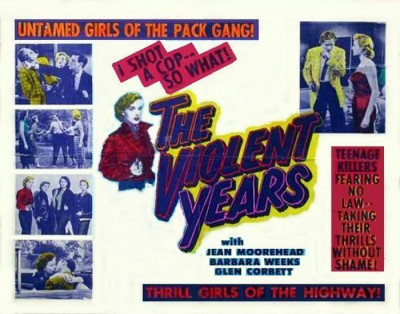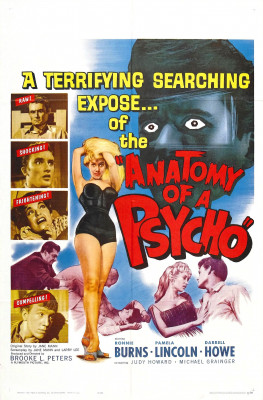| Reviews & Columns |
|
Reviews DVD TV on DVD Blu-ray 4K UHD International DVDs In Theaters Reviews by Studio Video Games Features Collector Series DVDs Easter Egg Database Interviews DVD Talk Radio Feature Articles Columns Anime Talk DVD Savant Horror DVDs The M.O.D. Squad Art House HD Talk Silent DVD
|
DVD Talk Forum |
|
|
| Resources |
|
DVD Price Search Customer Service #'s RCE Info Links |
|
Columns
|
|
|
Violent Years / Anatomy of a Psycho, The
In a prologue, the girl gang of Paula Parkins (pretty Jean Moorhead, a former Playboy centerfold) is introduced, each identified as each sashays contemptuously past a chalkboard outlining virtuous behavior ("Good Citizenship," "Self Restraint," etc.). The others are Geraldine (Joanne Cangi), Phyllis (Joanne Craig), and Georgia (Theresa Hancock).
Paula comes from a wealthy suburban family. Her father, Carl (Arthur Millan), is a newspaper editor too busy to spend quality time with his daughter; Paula's mother, Jane (Barbara Weeks), is an upwardly mobile socialite whose material gifts are a poor substitute for paternal guidance. The parents haven't a clue about Paula's criminal behavior though in their defense at home Paula appears perfectly wholesome.
The gang robs gas stations, though Paula isn't interested in the dough - she's doing it for kicks. They wear slouched hats, and kerchiefs over their faces, and the authorities seem unaware the thieves are young women. (As outrageous as this sounds, an episode of Highway Patrol a few years later operated from a very similar premise.) At Lover's Lane, they delight in humiliating a young couple, forcing the young woman to strip to her underwear and, quite surprising for a 1956 American movie, Paula quite clearly rapes the young man, albeit off screen.
Some of the items stolen from the couple they fence through Sheila (Lee Constant), who offers them a job trashing a public school on behalf of fifth columnists Communists. Later, at a "pajama party," Barney Stetson (Glen Corbett, not to be confused with Glenn Corbett), a reporter working at Carl's newspaper, discovers the girls talking trash and making out with two-bit hoodlums. Meanwhile, the police are closing in….
The movie's gleeful nihilism was no doubt a major influence on writer-director John Waters. The movie's signature line, "So what?" is like something Waters regular Mink Stole might say (and may well have), and much of the dialogue is amusingly contemptuous of social norms. In Waters's Polyester (1981), a newly pregnant teenager, after informing her distraught mother (Divine) adds, "I'm going to get an abortion and I CAN'T WAIT!" Most of the gang-speak in The Violent Years is a lot like that.
The film is extraordinarily cheap ($28,000) yet it's more competently directed than any of Wood's features made on similar budgets. Wood's dialogue is mostly terrible, but there are a few decent actors, like Corbett and I. Stanford Jolley, playing a judge, that make it almost palatable.
Seemingly titled to cash in on Hitchcock's classic film from the year before, the co-feature, Anatomy of a Psycho otherwise resembles Psycho not at all. It's a strange, disjointed, brooding psychological crime drama, with good and bad points.
Chet (Darrell Howe) is understandably upset that his older brother, a hoodlum he nonetheless looked up to, is to be executed later that evening. Inconsolable, despite the best efforts of his resigned sister, Pat (Pamela Lincoln), he heads to "Moe's shack," a dilapidated house gang leader Moe (Don Devlin) is apparently squatting, though director Boris Petroff denies the movie audience an establishing shot of the outside until the movie is nearly over. Moe and Chet's other pals are curiously nonchalant about Chet's torment as the minutes tick closer and closer to midnight. However, afterwards they are only too happy to aid help him with his bloodthirsty quest for vengeance, to track down all those responsible for his brother's conviction.
Other characters are introduced: Mickey (top-billed Ronnie Burns, the son of George Burns and Gracie Allen) is Pat's boyfriend, which creates some problems when he wants to introduce her to his father, Frank (Russ Bender), a witness to the murder that led to her brother's conviction. Michael Granger plays Lt. Mac, a friendly, humanist local detective sympathetic toward the gang he suspects is behind the brutal beatings. Meanwhile, Chet's girl, Sandy (Judy Howard) dumps him for rich snob Arthur (Pat McMahon) but that works out fine once Chet learns Arthur is also connected to the trial, beating Arthur to a pulp and setting his folks' expensive desert home ablaze.
The movie has its good points. Pock faced Michael Granger is pretty good as Lt. Mac, nearly overcoming his terrible dialogue. Granger was a longtime supporting player in B-movies, then won fame as Lazar Wolf, the butcher, in the original Broadway production of Fiddler on the Roof. Presumably he was cast after the script was written; as Lt. Mac he looks anything but Irish. Don Devlin, father of later director Dean Devlin, is also far better than the material, in a John Cassavetes sort of way, and co-wrote the script with Jane Mann. Ronnie Burns and Pamela Lincoln are also fairly decent actors, though Darrell Howe is terrible as Chet, hammy and amateurish.
The extreme low budget, well under $100,000, reveals itself in amusing ways. During an early fight scene, a character is pushed into a brick wall that wobbles so violently it nearly topples over, exposing it as a cheap flat. The interior sets are rudimentary in the extreme, with little in the way of set decoration. During the story three different front pages from different papers are shown, but all have the same stories under the headline with the same page layout. The film's geography is positively screwy. The first newspaper shown is the Ohio Gazette, but the party at Arthur's house looks like a mansion in Palm Springs, a rocky desert terrain. Later, footage of fire trucks rushing to the blaze have "Colorado Springs Fire Dept." emblazoned on the doors. (The IMDb reports the party scenes were filmed in Colorado Springs, but it sure doesn't look it to me.)
The script also has gaping holes of logic. Near the end, when Chet is at his most volatile and unpredictable, Lt. Mac allows Pat to enter Moe's shack unaccompanied, then allows angry Frank, determined to beat a confession out of Chet, to enter as well, all while the lazy cop stands around outside. The writers, Mann, Devlin, and maybe Ed Wood, haven't a clue how to depict Chet's inner struggle. His distress and belief in his brother's innocence seem perfectly reasonable at first, but then alternates between constant whining and unfettered rage, pounding his fists on tables before flipping them over and running amok.
Video & Audio
The Violent is presented in 1.78:1 widescreen, approximating its original 1.85:1 aspect ratio. It's reportedly sourced from the original 35mm camera negative in 4K, while Anatomy of a Psycho, also 1.78:1 utilizes a 35mm theatrical print and scanned at 2K. Neither movie looks pristine, but doubtlessly better than it has since its original run, probably limited to few houses in big cities and the grungiest of theaters. Both films show damage possibly dating back to when the pictures were originally shot, edited, and first printed, so complaints here are minimal. The DTS-HD Master Audio 2.0 mono is fine and, surprisingly, supported by optional English subtitles.
Extra Features
Loads. First there's a lively audio commentary track featuring filmmaker Frank Henenlotter (Basket Case, Frankenhooker) and musician-writer Rudolph Grey, whose outstanding oral biography of Ed Wood, Nightmare of Ecstasy, formed the basis for Tim Burton's later film. Beyond the trailer for The Violent Years, there's an additional 15 minutes of "Gutter Noir Trailers," nearly all of which are actually lesser French movies from the 1950s and early ‘60s, dubbed into English and fascinatingly sold as both award-winning art house titles and as soft-core sex films sizzling lovemaking and nudity. Prominent French actors like Jeanne Moreau turn up in these mostly forgotten features. Also included is ten minutes of VHS-sourced silent footage from Ed Wood's abandoned Hellborn, and a great booklet highlighting Violent Years material culled from the Something Weird paper archive.
Parting Thoughts
Exquisite trash, lovingly presented, The Violent Years (with Anatomy of a Psycho) is Highly Recommended.
Stuart Galbraith IV is the Kyoto-based film historian largely absent from reviewing these days while he restores a 200-year-old Japanese farmhouse.
|
| Popular Reviews |
| Sponsored Links |
|
|
| Sponsored Links |
|
|
| Release List | Reviews | Shop | Newsletter | Forum | DVD Giveaways | Blu-Ray | Advertise |
|
Copyright 2024 DVDTalk.com All Rights Reserved. Legal Info, Privacy Policy, Terms of Use,
Manage Preferences,
Your Privacy Choices | |||||||















